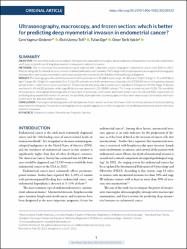| dc.contributor.author | Özdemir, Cem Yağmur | |
| dc.contributor.author | Üzmez Telli, Elçin | |
| dc.contributor.author | Öge, Tufan | |
| dc.contributor.author | Yalçın, Ömer Tarık | |
| dc.date.accessioned | 2023-09-22T10:37:56Z | |
| dc.date.available | 2023-09-22T10:37:56Z | |
| dc.date.issued | 2023 | en_US |
| dc.identifier.citation | Ozdemir, C. Y., Telli, E. U., Oge, T., & Yalcin, O. T. (2023). Ultrasonography, macroscopy, and frozen section: whıch is better for predicting deep myometrial invasıon in endometrial cancer?. Revista da Associação Médica Brasileira, 69, e20230333. | en_US |
| dc.identifier.uri | https://dx.doi.org/10.1590/1806-9282.20230333. | |
| dc.identifier.uri | https://hdl.handle.net/20.500.12933/1591 | |
| dc.description.abstract | Objective: The aim of this study was to compare the power of preoperative transvaginal ultrasonography, intraoperative macroscopic examination, and frozen section for predicting deep myometrial invasion in endometrial cancer.
Methods: This is a retrospective review involving 68 patients who underwent surgical staging for endometrial cancer from 2014 to 2017. Patients with grade 3 endometrial cancer and non-endometrioid tumors were excluded. The findings related to preoperative transvaginal ultrasonography, intraoperative macroscopic examination, and frozen section were compared with definitive histopathological diagnosis.
Results: The mean age, gravidity, and body mass index of the patients were 58.1±8.9 years (range: 30-80 years), 3.2±2.1 (range: 0-9), and 33.5±6.6 kg/m2 (range: 20-52 kg/m2), respectively. Only 11 (16.2%) patients were in the premenopausal period, while 57 (83.8%) were in the postmenopausal period. Grade 1 endometrial cancer was found in 29 patients (42.6%) and grade 2 tumors were specified in 39 patients (57.4%). Stage IA disease was found in 45 (66.2%) patients, while stage IB disease was observed in 23 (33.8%) patients. The 5-year survival rate was 91.2%. The sensitivity of preoperative transvaginal ultrasonography, intraoperative macroscopic examination, and frozen section were 56, 34, and 52%, respectively, for predicting deep myometrial invasion. In contrast, the specificity of preoperative ultrasonography, intraoperative macroscopic examination, and frozen section were 86, 100, and 100%, respectively.
Conclusion: Transvaginal ultrasonography and intraoperative frozen section were found to have similar sensitivity and specificity for predicting deep myometrial invasion. Preoperative transvaginal ultrasonography appears as an efficient approach for predicting endometrial cancers with deep myometrial invasion. | en_US |
| dc.language.iso | other | en_US |
| dc.publisher | Associação Médica Brasileira | en_US |
| dc.relation.isversionof | 10.1590/1806-9282.20230333. | en_US |
| dc.rights | info:eu-repo/semantics/openAccess | en_US |
| dc.subject | Endometrial Cancer | en_US |
| dc.subject | Myometrium | en_US |
| dc.subject | Prognosis | en_US |
| dc.subject | Survival | en_US |
| dc.title | Ultrasonography, macroscopy, and frozen section: whıch is better for predicting deep myometrial invasıon in endometrial cancer? | en_US |
| dc.type | article | en_US |
| dc.authorid | 0000-0001-5560-2162 | en_US |
| dc.department | AFSÜ, Tıp Fakültesi, Cerrahi Tıp Bilimleri Bölümü, Kadın Hastalıkları ve Doğum Ana Bilim Dalı | en_US |
| dc.contributor.institutionauthor | Özdemir, Cem Yağmur | |
| dc.identifier.volume | 69 | en_US |
| dc.identifier.issue | 10 | en_US |
| dc.relation.journal | Revista da Associação Médica Brasileira | en_US |
| dc.relation.publicationcategory | Makale - Ulusal Hakemli Dergi - Kurum Öğretim Elemanı | en_US |
















